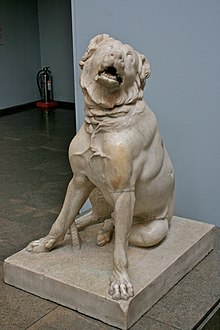Molossian hound
It has been suggested that this article be merged with Molossus of Epirus. (Discuss) Proposed since June 2020. |
| Molossus | |
|---|---|
 The “Jennings Dog", a Roman copy of a lost Greek bronze statue, on display in the British Museum. | |
| Other names | Μολοσσός Molossian hound |
| Origin | Ancient Greece |
| Dog (domestic dog) | |
The Molossus (Greek: Μολοσσός) or Molossian hound was a breed or type of large dog in the ancient kingdom of Molossis, in the region of Epirus, now western Greece.[1]
History
The Molossus was famous throughout the ancient world for its size and ferocity. It is mentioned in ancient literature by, among others: Aristophanes,[2], Aristotle,[3] Grattius,[4] Horace,[5][6] Lucan,[7] Lucretius,[8] Martial,[9] Nemesianus,[10] Oppian of Apamea,[11] Plautus,[12] Seneca,[13] Statius,[14][15][16] and Virgil.[17] Suda also mentioned it.[18][19]
The Molossians issued silver coinage with an image of a Molossus as their emblem.[1]
The Molossians kept dogs of two distinct types, one a hunting dog with a broad muzzle which is sometimes considered the ancestor to the modern mastiff type, the other a large livestock guardian dog. Aristotle in his History of Animals wrote "In the Molossian race of dogs, those employed in hunting differ in no respect from other dogs; while those employed in following sheep are larger and more fierce in their attack on wild beasts."[3] He also added that dogs that are born of a mixed breed between the Molossian and the Laconian dogs are remarkable for courage and endurance of hard labor.[20][21]
Polycrates of Samos imported Molossian and Laconian dogs to the island.[22]
Modern kennel club classification
The Fédération Cynologique Internationale has a "Molossian type" grouping of modern dog breeds which is further divided into two sections, a mastiff type and mountain type.[23]
See also
References
- ^ a b David Hancock, (2001). The Mastiffs: The Big Game Hunters: Their History, Development and Future. Ducklington: Charwynne Dog Features. ISBN 9780951780114.
- ^ Aristophanes, Thesmophoriazusae, 416.
- ^ a b Aristotle, History of Animals, IX. I. 2. Translated by Richard Cresswell, London: George Bell & Sons, 1887.
- ^ Grattius, Cynegeticon, 169.
- ^ Horace, Epodes,VI.
- ^ Horace, Satires 2, VI. 114.
- ^ Lucan, Pharsalia, IV. 440.
- ^ Lucretius, De rerum natura, V. 1063.
- ^ Martial, Epigram, XII. I. 1.
- ^ Nemesianus, Cynegetica, 107.
- ^ Oppian, Cynegetica, I. 375.
- ^ Plautus, Captivi, 86.
- ^ Seneca, Phaedra, 33.
- ^ Statius, Achilleid, I. 747.
- ^ Statius, Silvae, II. VI. 19.
- ^ Statius, Thebaid, III. 203.
- ^ Virgil, Georgics, III. 405.
- ^ Suda, ka.2730
- ^ Suda, mu.1198
- ^ Aristotle, History of Animals, 9.1.4
- ^ Aristotle, History of Animals - GR
- ^ Athenaeus, Deipnosophists, 12.57
- ^ FCI breeds nomenclature: Group 2: Pinscher and Schnauzer - Molossoid and Swiss Mountain and Cattledogs. Fédération Cynologique Internationale. Accessed June 2020.
Further reading
- Edward Cecil Ash (1927). Dogs: Their History and Development. London: Ernest Benn.
